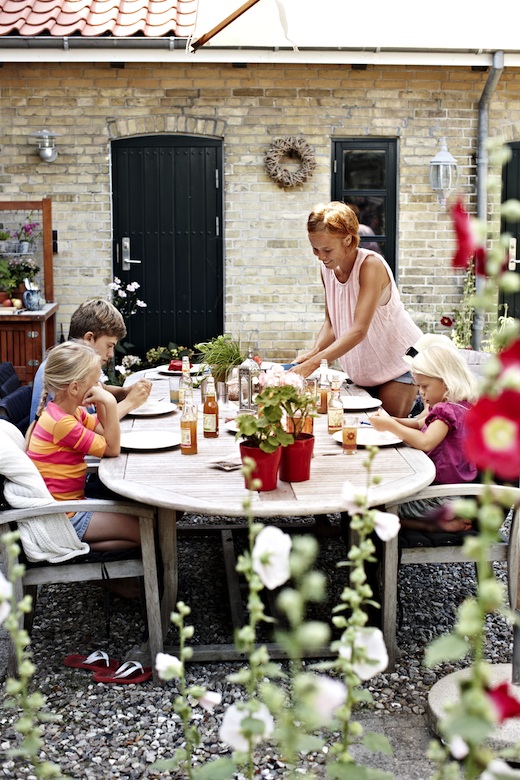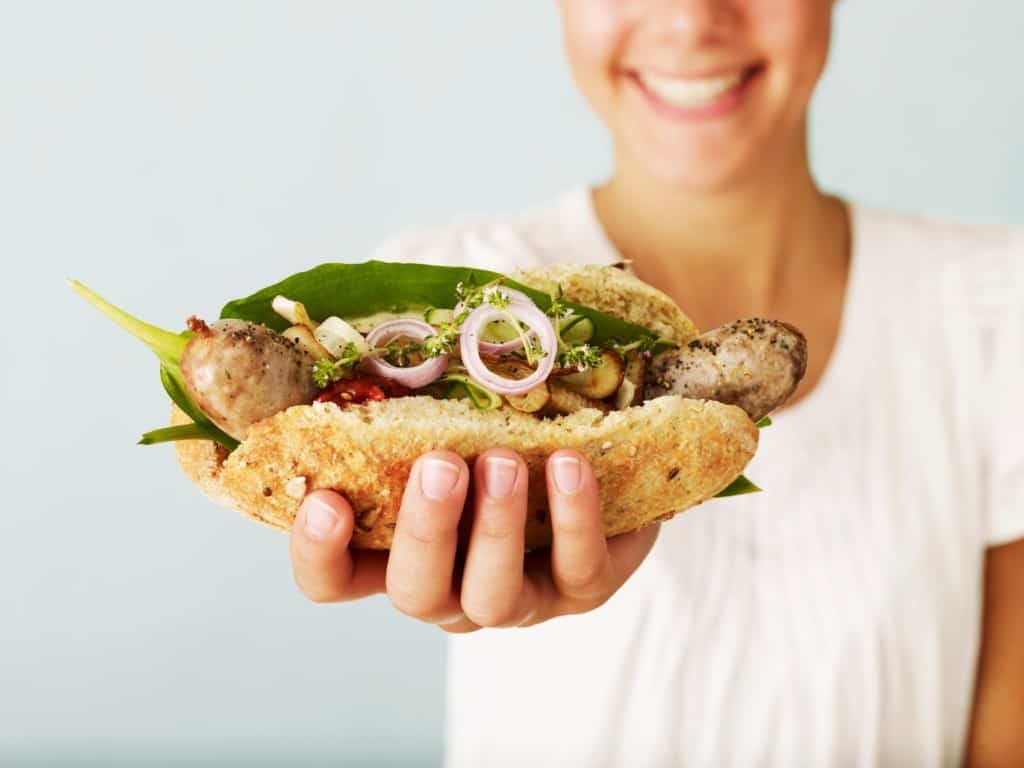The Kingdom of Denmark is surrounded by water on three sides. Therefore, of course, fish plays an important role in Danish cuisine. But there is also a lot of agriculture on the fertile soil. People in Denmark know how to enjoy themselves. One eats with pleasure and often. The day begins with Morgenmad, the Danish breakfast. Frokost is a cold snack that is taken for lunch. This is followed by the eftermiddag coffee. Middagsmad is the main warm meal of the day. Even if the term suggests lunch: The Danes eat their middagsmad in the evening. This meal is also known as aftensmad in Danish. In between, the appetite is satisfied with a hot dog or another sausage at the snack bar.
Well-known dishes in Denmark
One of the best-known terms from Nordic and therefore also from Danish cuisine is smørrebrød. This just means a sandwich. In Scandinavia, smørrebrød is part of a traditional frokost, or lunch. When it comes to topping the slices of bread coated with salted butter, variety is the order of the day: caviar, crabs and fish, sausage and pies, cold sliced meat and cheese form the basis of the generous bread topping. The sandwich is then garnished with eggs, vegetables, lettuce, fruit and various sauces. Smørrebrød is eaten by hand at home and on the go. In the restaurants, guests can choose the topping for their lunch from a rich buffet of hot and cold ingredients.
The menu in Denmark is largely determined by what the fishermen land fresh every day. Specialties such as saithe, plaice, cod, cod and of course herring and mackerel can be found in many Danish dishes. Gammel danske kaus is regularly served on the plate. It is a kind of Labskaus, as we know it in northern Germany. The hearty dish consists of beef, herring, rollmops, beetroot, onions, pickled cucumbers, onions and potatoes. In Denmark it is served on slices of bread. A fried egg comes on top. Fish cakes, a crab-filled plaice, or boiled cod with hard-boiled eggs and boiled potatoes are popular Danish fish dishes. Stjerneskud is a colorful salad that is served with fish and seafood.
Kogt Hamburgerryg is cooked smoked pork, which comes on the table with colorful vegetables and potatoes. Boiled and roasted ham, pork roast or liver pate are other Danish specialties. The warm evening meal is often fish or different types of meat with vegetables and sauce.

Another classic of Danish cuisine is served for dessert: red grits with cream, which in Denmark is called Rødgrød med fløde. It tastes very fruity and has just the right balance between sour and sweet. The Danish red grits are only lightly bound with cornstarch. It has a creamy and rather thick consistency. Danish ice cream comes in many flavors. It is crowned with Guf, a sweet frothy sauce made from egg white, sugar and some gelatine. There are also fruits or a fruit sauce.
Eftermiddag coffee
Wienerbrød, which is also known as Copenhagen pastry, is popular as a sweet snack or with afternoon coffee. The very rich puff pastry is used in pastries and croissants. Sometimes the pastry pieces are filled with a kind of vanilla pudding or another cream. The bakery trade in Denmark also has a large selection of sweet rolls, cinnamon rolls, donuts and cakes to offer. The Danes especially like the apple pie in many variations with their coffee. Sønderjysk Kaffebord, which comes from the south of Jutland, a Danish province, is now common all over Denmark. In Denmark, people like to eat in large groups. Large buffets are set up for all meals, especially for festivities such as Christmas, birthdays or other family celebrations. If the guests are there, they will dine for hours. With a classic coffee shelf, there is a large selection of tarts, cakes and pastries to go with tea or coffee. People drink a lot of coffee in Denmark. Large quantities of it are not only enjoyed in the afternoon. Even after a long feast there is a strong black coffee even at midnight.
A big swig
After all the hearty and sweet delicacies, you need a strong sip for digestion. Caraway seeds, dill seeds and other spices are the basis for the Nordic water of life, the aquavit. It is enjoyed chilled. If possible, the shot glasses should also be pre-cooled in the freezer. Danish beer is known all over the world. It is toasted with a strong skà ¥ l.
A small snack in between
The small snack between main meals is important. The hot dog is not an American invention as many people believe. The hot sausage in a bun is a culinary export from Denmark. The hot dog is available there as a hearty snack at any time of the day or night. The sausage is wrapped in a soft roll. For this purpose, slices of sweet and sour pickles, fried onions, mustard, ketchup and a spiced tartar sauce are filled into the roll. The intense red color of the sausage is unusual for anyone who does not come from Denmark. In addition to the hot dog, the hungry guest can choose from a variety of cooked and fried sausages at the snack bar. They are all served with plenty of tartar sauce or ketchup.
Danish liver paste (Leverpostej)
This Danish classic is always in season.
Ingredients:
– 600 g pork liver
– 400 g of bacon
– 75 g butter
– 75 g of flour
– 250 ml of milk
– 1 small onion
– 4 eggs
– 1 teaspoon of pepper
– 2 teaspoons of salt
Turn the liver and bacon together with the peeled onion through the meat grinder. Melt the butter in a saucepan, add the flour and dilute with the milk. Cook the roux well. Take the saucepan out of the fire, stir in the bacon and liver with the eggs one after the other. Mix with salt and pepper and pour the whole mixture into a greased bowl. Place in a water bath in the oven and bake for about 1 hour at 170 ° C. Serve the liver pate lukewarm with toasted bacon and mushrooms on black bread.
What do you eat at Christmas in Denmark?
Danes love good food and drink all year round, especially during the festive season. In addition to the eagerly anticipated Christmas dinner, the Danes spend the time before and after Christmas with festive lunches and dinners with friends, colleagues and family. Many Danish Christmas traditions are centered around a table full of delicious food and chairs full of good company.
Danish Christmas dinner
The traditional Danish Christmas dinner is roast pork, boiled potatoes, red cabbage and gravy, although roast duck and goose have become popular recently. For dessert, the classic dish is ris à l’amande; cold rice pudding with whipped cream, vanilla, almonds and hot cherry sauce or “rosegrod” (hot rice pudding). A peeled almond is hidden in the dessert bowl and the lucky finder of the almond gets a present.
Most Danes will attend one or more Christmas dinners in December. Christmas dinners are a traditional way to extend Christmas celebrations beyond the close family to friends and colleagues and to get the Danes into the festive mood early! Book your own Christmas dinner in Denmark – most hotels and restaurants have special Christmas dishes on their menus and cater for festive groups. The menus include traditional dishes such as smoked salmon, herring or liver pate with bacon and mushrooms. Wash it all down with a Christmas beer, a celebratory glass of wine or, if you’re really brave, with a dash of Christmas schnapps.
